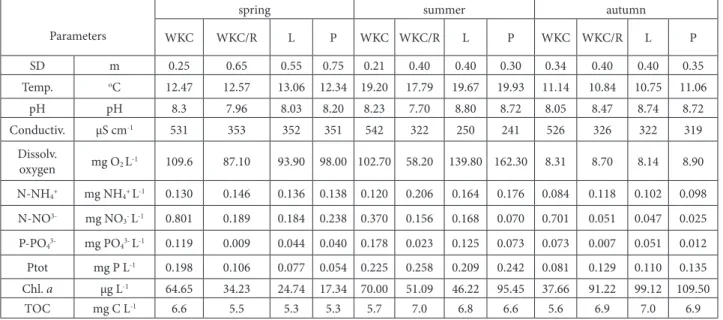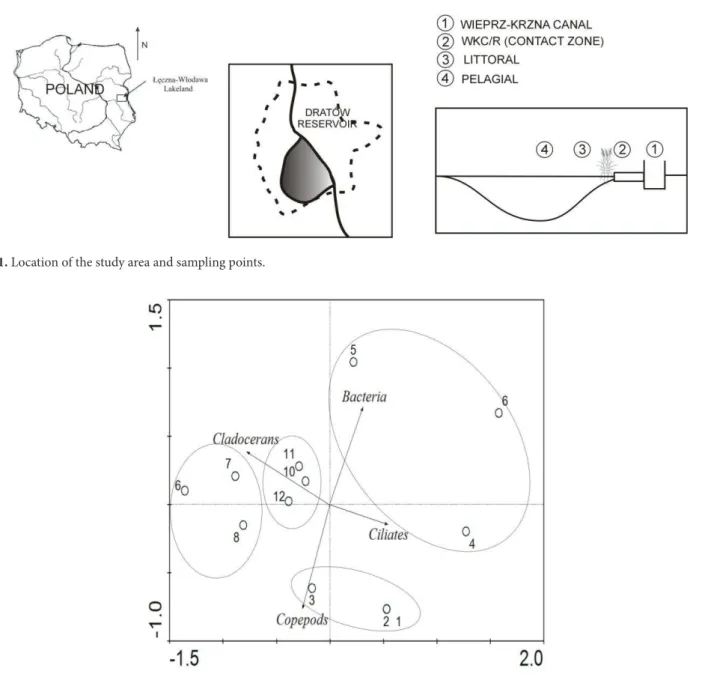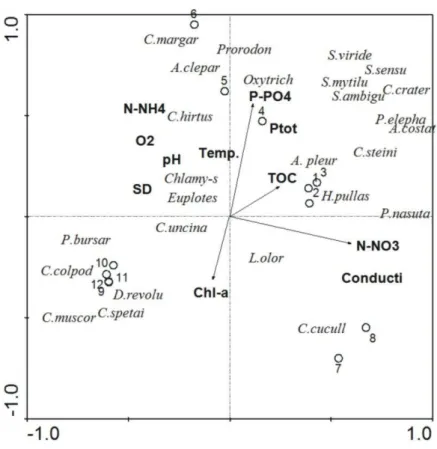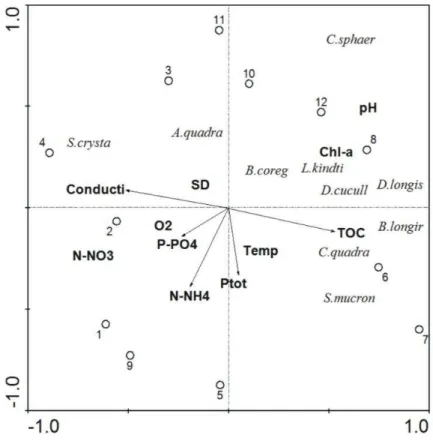1491
EFFECT OF WATER CHEMISTRY ON THE PLANKTONIC COMMUNITIES AND RELATIONSHIPS AMONG FOOD WEB COMPONENTS ACROSS A FRESHWATER ECOTONE
T. MIECZAN*, MAŁGORZATA ADAMCZUK and DOROTA NAWROT
Department of Hydrobiology, University of Life Sciences in Lublin, 20-262 Lublin, Poland
Abstract - Most ecological research on the food web has been focused more on the pelagic zone than on the transitional zone – ecotones between lentic and lotic habitats. he speciic goals of this study were to determine whether the contact zone of waters difers in hydrochemical and biological terms from the waters of the canal and the open water zone, and to evaluate the inluence of particular macro-habitats on the interactions between components of the planktonic food web. he distribution of samples in ordination space led us to conclude that the studied habitats are distributed along the ris-ing gradient of total organic carbon and nutrients. Assemblages of all investigated groups showed a strong compositional gradient correlated with conductivity and total phosphorus, while a second strong gradient in species composition was ex-plained by nitrate nitrogen and/or phosphate concentrations. he analysis of trophic relationships in the system bacteria-ciliates-crustaceans reveals a clear diferentiation and strength of mutual relations between the analyzed zones. he highest number of signiicant correlations was determined in the contact zone. It can also be a place of very eicient matter and energy low in freshwater ecosystems.
Key words: Reservoir, ecotone, food web, bacteria, ciliates, crustacean
INTRODUCTION
he boundaries between water bodies (lakes, ponds, reservoirs) and adjacent terrestrial patch-es play an import role in coupling terrpatch-estrial with aquatic ecosystems. Ecotones are transition zones between relatively homogenous areas or patches. hey are zones in which environmental gradients are steepened, where rates of change in ecological patterns and processes are increased relatively to the surrounding. he canal-reservoir system may thus be perceived a spatial system of two kinds of ecosystems or patches. Ecotonal zones of these patches would be formed by the zones of mixing the reservoir water with river/canal water (Hillbricht-Ilkowska and Węgleńska, 2003). he zone of river inlow to a reservoir functions as a barrier system
knowledge exists concerning the regulating mecha-nisms between microorgamecha-nisms with respect to spe-cies composition and abundance of crustaceans in freshwater contact zones. he classical grazer food chain and the planktonic food web are linked by several direct and indirect interactions. Metazoan grazing is important for the recycling of nutrients and production of dissolved organic substrates for bacteria, but it is also a controlling factor for the protozoan community structure. Zooplankton predation, mainly by copepods, on ciliates is well documented in pelagic zones (Jack and Gilbert, 1997). However, our knowledge of the distribution and regulating factors of microorganisms in tran-sitional zones is still fragmentary. he irst step in understanding the structural and functional sig-niicance of these microorganisms is the analysis of density and biological diversity between diferent zones. Because the canal/reservoir zone is recog-nized as an ecotone (the contact zone between two diferent ecosystems), it was assumed that it should show signiicant diferences of physical and chemi-cal water parameters from adjacent habitats, and be distinguished by high species richness and abun-dance of bacteria, ciliates and crustaceans, includ-ing the occurrence of species typical of the zone. According to di Castri et al. (1988), ecotones are transitional zones between relatively homogenous areas or patches and characterized by high struc-tural and spatial diversity. hey are zones in which environmental gradients are steepened, where rates of change in ecological patterns and processes are increased relatively to the surrounding. he speciic goals of the study were: i) to analyze the taxonomic composition and abundance of microbial and crus-tacean communities, ii) to describe environmental variables responsible for the distribution of bacte-ria, ciliates and crustaceans in an adjacent canal, ecotone and reservoir (littoral-pelagic zone); iii) to determine whether the contact zone waters difer in hydrochemical and biological terms from the wa-ters of the canal and the open water zone; and iv) to evaluate the inluence of particular macro-habitats (canal, canal/reservoir, littoral, pelagic zone) on the interactions among components of the planktonic food web.
MATERIALS AND METHODS
Study area
Lake Dratów is a storage, eutrophic reservoir (sur-face area 167.9 ha, max depth 2.9 m) situated in the area of Łęczna-Włodawa Lakeland (eastern Poland) (Fig. 1). Over 80% of the lake catchment is used for agriculture purposes (mostly arable lands and mead-ows). In 1961, this lake was placed into the Wieprz-Krzna Canal (W-KC). Additionally, in the zone of W-KC, 13 lakes were transformed into storage res-ervoirs (Dawidek et al., 2004). As a result of feeding with canal waters, the rate of water exchange in the lakes increased and its quality and trophic conditions improved. he hydrotechnological facilities are ei-cient, carefully maintained and failure-free. he wa-ter in the reservoir is exchanged several times in a hydrological year, irrespective of the natural feeding system (Dawidek et al., 2004). Dratów reservoir is characterized by permanent and long-lasting blooms of cyanophyte. Emergent vegetation is dominated by common reed (Phragmites australis (Cav.) Trin. ex Steud.), bulrush (Schoenoplectus lacustris (L.) Palla) and broadleaf cattail (Typha latifolia L.). Submerged vegetation is limited to very small, single stands of rigid hornwort (Ceratophyllum demersum L.) and sago pondweed (Potamogeton pectinatus L.).
Sampling and identiication
Microbial communities (bacteria and ciliates) and crustaceans (cladocerans and copepods) were exam-ined in a transect including 1 – Wieprz-Krzna Canal (WKC), 2 – contact zone: canal/reservoir (WKC/R), 3 – littoral zone (L), 4 - pelagic zone (P) (Fig. 1). he samples were taken from April to October 2012. Col-lected data were presented in three seasons, spring (April), summer (July) and autumn (September). During each sampling occasion, three samples were collected from each site. At each of the sites, samples were collected with a 5-liter Bernatowicz sampler.
micro-scopy, according to the method of Porter and Fleig (1980). 10 ml of water was preserved with formalde-hyde to a inal concentration of 2% and kept in the dark at 4oC. Four slides were made from each sample
in which subsamples of 2 ml were iltered on 0.2 µm pore-size polycarbonate ilters that were stained with Irgalan Black. he bacteria were counted in 250 ran-domly chosen ields of view.
he abundance of ciliates and their community composition were determined using Utermöhl’s method. 5 l samples were iltered through a plank-ton net of 10 µm mesh size. Protozoa samples (whole sample = 500 ml) was sedimented for 24 h in a cyl-inder, stoppered with parailm, then the upper was gently removed. In order to determine the density, three samples were preserved with Logol’s solution and stored in the dark at a temperature of 4°C. Ob-servation of live samples was used for the taxonomic and trophic identiication. Ciliates are highly perish-able, and their type of motility is a species-speciic feature; for this reason, species determination and measurements were carried out on live material im-mediately ater return to the laboratory and ater silver impregnation (Augustin et al., 1984). Morpho-logical identiications were mainly based on works by Foissner and Berger (1996), Foissner et al. (1999). Crustaceans (Cladocera and Copepoda) were col-lected with the use of a 5-L sampler. Double samples were collected and pooled to reduce heterogeneity in crustacean distribution and sampling variability. Samples were sieved through in a 40 µm mesh net and ixed with a formalin-glycerin solution. In the laboratory, the classiication and counts of crusta-ceans were made with the use of the Sedgewick-Rat-er cell to calculate abundance expressed as a numbSedgewick-Rat-er of individuals per 1 l-1.
Biovolumes of each microbial community were estimated assuming geometric shapes and converting to carbon using the following conversion factor: het-erotrophic bacteria: 1 µm3 = 5.6 x 10-7 mgC; ciliates:
1 µm3 = 1.1 x 10-7 mgC (Gilbert et al., 1998). Ciliate
biomass was estimated by multiplying the numerical abundance by the mean cell volume (1 µm3 = 1 pg)
calculated from direct volume measurements using
appropriate geometric formulas (Finlay, 1982). An obvious shrinkage of stained ciliates was observed in the silver preparation. he calculated cell volumes were multiplied with a correcting factor of 0.4 (Jer-ome et al., 1993). Crustacean biomass was estimated via the relations between body length and body mass of a given specimen (Dumont et al., 1975; Bottrell et al., 1976; Culver et al., 1985) by applying established mathematic formulas.
Abiotic variables
Once a month, the water samples (volume of 500 ml) for chemical analyses were taken. Temperature, conductivity, pH and dissolved oxygen (DO) were determined in situ with a multiparametric probe, total organic carbon (TOC) was determined using the spectrophotometer PASTEL Uv and the remain-ing factors (TP – total phosphorus, P-PO4, N-NH4,
N-NO3, chlorophyll a) were analyzed in the
labora-tory (Golterman, 1969).
Data analyses
Diversity analysis (Shannon Wiener diversity index (log10-based)) was performed using the Multivariate
permu-tations), was used to determine the most important variables (Lepš and Šmilauer, 2003). variables whose level of signiicance exceeded 0.05 were plotted pas-sively on the diagrams. On the resultant plot, the arrows representing the physicochemical variables indicate the direction of maximum change of that variable, and the length of each arrow is proportion-al to the rate of change. he proportion of variance explained by environmental variables was quantiied using variance partitioning. he ordination analyses were performed by means of CANOCO 4.5 for Win-dows.
RESULTS
Abiotic variables
Physical and chemical water parameters showed vis-ible seasonal variability (Table 1). Observed values were typical for hypertrophic lakes. Secchi disc vis-ibility was very low and ranged from 0.40 m to 0.75 m. Statistically signiicant diferences among the in-vestigated sites were found in conductivity, nutrients, TOC and concentrations of chlorophyll a (ANOvA, F = 26.22-29.71, P = 0.001). Water pH luctuated from 7.70 in WKC to 8.74 in L. Conductivity was signiicantly diferentiated, attaining from >350 µS cm-1 in P to 542 µS cm-1 in WKC. he highest
con-ductivity occurred in spring and summer, but was decidedly lower in autumn. At all sites examined, the water temperature reached the highest value in sum-mer (>17oC), and decreased in autumn (<9oC). he
highest concentrations of TOC occurred in WKC and/or WKC/R (>6 mgC L-1). he concentration of
total organic carbon luctuated between 5.3-6.6 mgC L-1 in spring and 5.3-7 mgC L-1 in summer. Nutrients
reached the highest values in the WKC and WKC/R, and were the highest during the spring and autumn periods. WKC had a higher concentration of chloro-phyll a in spring and the pelagic zone in summer and autumn (Table 1).
Bacteria, ciliates and crustaceans
he highest mean bacterial numbers and biomass were noted in the littoral (L) and contact zones:
ca-nal/reservoir (WKC/R) (111 x 106 cells ml-1 and 2.49
mg C l-1 and 81 x 106 cells ml-1 and 1.59 mg C L-1,
respectively), the lower values were characteristic for the pelagic zone (P) (45 x 106 cells ml-1 and 1.09 mg
C l-1, respectively). he Wieprz-Krzna Canal (WKC)
was characterized by the lowest numbers and bio-mass of bacteria (36 x 106 cells ml-1 and 0.88 mg C
l-1, respectively). In the pelagic and littoral zones,
the numbers of bacteria were very low in summer and reached a maximum in spring and autumn; in KWC and KWC/R the highest numbers of bacteria occurred in spring and the lowest in summer.
related to the type of macro-habitat, with the low-est numbers in the P (22 ± 2 individuals ml−1) and
the highest in the WKC/R (56 ± 6 individuals ml−1)
(ANOvA, F = 18.5, p = 0.001). Ciliate biomass, corresponding with abundances, was signiicantly higher in the WKC/R (137 ± 11 µg C ml−1) than in
L (96 ± 7 µg C ml−1) (ANOvA, F = 21.2, p = 0.001).
he community composition of ciliates varied great-ly between habitats. Prorodon sp. and Caenomorpha spp. dominated in the KWC while Cinetochilum margaritaceum, Colpoda cucullus, Euplotes sp.,were prevalent in the WKC/R. In L and P, the
communi-Table 1. Physical and chemical characteristics of water in investigated habitats (WKC - Wieprz-Krzna Canal, WKC/R – contact zone: canal/reservoir, L – littoral zone, P – pelagic zone)
Parameters
spring summer autumn
WKC WKC/R L P WKC WKC/R L P WKC WKC/R L P
SD m 0.25 0.65 0.55 0.75 0.21 0.40 0.40 0.30 0.34 0.40 0.40 0.35
Temp. oC 12.47 12.57 13.06 12.34 19.20 17.79 19.67 19.93 11.14 10.84 10.75 11.06
pH pH 8.3 7.96 8.03 8.20 8.23 7.70 8.80 8.72 8.05 8.47 8.74 8.72
Conductiv. µS cm-1 531 353 352 351 542 322 250 241 526 326 322 319
Dissolv.
oxygen mg O2 L-1 109.6 87.10 93.90 98.00 102.70 58.20 139.80 162.30 8.31 8.70 8.14 8.90
N-NH4+ mg NH4+ L-1 0.130 0.146 0.136 0.138 0.120 0.206 0.164 0.176 0.084 0.118 0.102 0.098
N-NO3- mg NO
3- L-1 0.801 0.189 0.184 0.238 0.370 0.156 0.168 0.070 0.701 0.051 0.047 0.025
P-PO43- mg PO43- L-1 0.119 0.009 0.044 0.040 0.178 0.023 0.125 0.073 0.073 0.007 0.051 0.012
Ptot mg P L-1 0.198 0.106 0.077 0.054 0.225 0.258 0.209 0.242 0.081 0.129 0.110 0.135
Chl. a µg L-1 64.65 34.23 24.74 17.34 70.00 51.09 46.22 95.45 37.66 91.22 99.12 109.50
TOC mg C L-1 6.6 5.5 5.3 5.3 5.7 7.0 6.8 6.6 5.6 6.9 7.0 6.9
Table 2. Results of main efects ANOvA on density of bacteria, ciliates and crustaceans testing for the efect of the time (season) and the site (horizontal distribution)
df SS MS F p
Density of bacteria
Intercept 2 79.01 75.01 98.28 <0.001**
Site (Si) 2 11.00 11.03 13.97 <0.001**
Season (Se) 6 0.46 0.54 7.43 0.055
Si x Se 2 2.18 9.12 17.35 0.033*
Density of ciliates
Intercept 1 21.11 21.12 58.12 <0.001**
Site (Si) 2 5.92 2.95 50.75 <0.001**
Season (Se) 8 0.81 0.11 8.52 0.080
Si x Se 2 0.57 3.31 8.19 0.036*
Density of crustaceans
Intercept 1 43.74 43.71 24.81 <0.001**
Site (Si) 2 14.72 19.32 5.81 <0.001**
Season (Se) 8 5.76 7.21 3.52 0.082
Si x Se 2 2.36 1.53 4.62 0.071
ties were predominantly composed of Paramecium bursaria, and Halteria grandinella.
he numbers of cladocerans ranged from 465 ± 16 individuals l-1 in L to 6490 ± 11 individuals l-1
in WKC/R. In all the examined habitats the highest
abundance of these organisms occurred in summer (from 155 ± 8 individuals l-1 in the WKC to 10490 ±
13 individuals l-1 in the LG), while the lowest values
were recorded in spring. he cladoceran biomass was signiicantly higher in the WKC (151 ± 11 mg l−1)
than in the other zones (<39 ± 7 mg l−1) (ANOvA,
Fig. 1. Location of the study area and sampling points.
F = 27.2, p = 0.001). Distinct horizontal diferences were noted in the domination structure of cladocer-ans. Bosmina longirostris dominated in the KWC/R and L, while Chydorus sphaericus and Bosmina core-goni were prevalent in the pelagic zone. In WKC, the communities were predominantly composed of B. coregoni, and nauplii. In the littoral zone, only one species of Cladocera typical of the zone occurred, namely Alona quadrangularis. In the KWC and P, no typical species were recorded. he numbers and bio-mass of copepods varied between 1 and 555 ± 8
indi-viduals l-1 and 0.001 and 2.7 ± 0.4 mg l-1 , respectively,
vicinus. In the case of the KWK, only one exclusive species, Eucyclops macrurus, occurred.
Ordination analyses
PCA axis 1 (λ = 0.394) and axis 2 (λ =0.182) explained 57.4% of the total variance in planktonic composi-tion. he irst two axes showed a clear separation of the studied planktonic communities and habitats. he abundances of cladocerans and copepods were most strongly correlated with the main direction of variation (axis 1). Axis 2 was the most strongly corre-lated with abundance of bacteria and ciliata as well as with samples collected in WKC/R (Fig. 2). RDA
per-formed in order to specify the direct relationships be-tween abundances of taxonomic groups of planktonic communities and environmental variables, showed evident diferences between the studied habitats. All variables together explained 45.7% of total variance. However, variables that signiicantly (P < 0.05, Mon-te Carlo permutation Mon-test) explained the variance in planktonic communities abundance were TOC (λ = 0.17; F = 4.66; P = 0.006), N-NH4 (λ = 0.09; F = 3.21;
P = 0.014), conductivity (λ = 0.11; F = 3.16; P = 0.02), pH (λ = 0.09; F = 3.06; P = 0.02), P-PO4 (λ = 0.06; F =
3.47; P = 0.026) and chlorophyll-a (λ = 0.16; F = 2.66; P = 0.044). In the RDA biplot for plankton taxonom-ic groups, axis 1 appeared to separate the diferent
components of planktonic food web; bacteria and ciliates are separated from cladocerans and cyclo-poids (Fig. 3A). he RDA biplot for sites shows the direct efect of habitat on planktonic community. On the biplot it can be observed that samples collected in WKC (I group) are separated from those collected in P (II group) and WKC/R – L (III group) (Fig. 3B), and this may correspond with abundances of ciliata (Fig. 3A). However, RDAs performed on each plank-tonic community separately (ciliates, cladocerans, copepods) showed diferences in relations between environmental variables and their density. he RDA for spatial distribution of ciliates showed that all en-vironmental variables together explained 77% of the
total variance. Monte Carlo permutation test showed the signiicance of P-PO4(λ = 0.34, F = 11.28, P =
0.002), N-NO3 (λ = 0.06, F = 2.78, P = 0.04), TOC (λ
= 0.08, F = 3.40, P = 0.048) and chlorophyll-a (λ = 0.06, F = 2.73, P = 0.049) in explaining the variability of ciliates in all habitats. On the RDA biplot, sam-ples are divided into three groups (habitats): WKC, WKC/R and L-P. he species commonly observed in WKC (Amphileptus pleurosigma, Holosticha pullaster, Plagiopyla nasuta, Colpoda steinii) correspond with the gradient of N-NO3. he species observed in the
WKC/R habitat, Cinetochilum margaritaceum, Pro-rodon sp., Amphileptus cleparedei and Oxytricha sp., correspond with P-PO4. he ciliates, Colpoda
lus, Cyrtohymena muscorum, Coleps spetai, Drepano-monas revoluta, Colpidium colpoda and Paramecium bursaria mostly correspond with L and P habitats and may be inluenced by chlorophyll-a (Fig. 4). For cladocerans, all environmental variables explained 54.5% of the total variability. Monte Carlo permu-tation test showed the signiicance of ive variables: TOC (λ = 0.22, F = 6.16, P = 0.0024), P-PO4 (λ = 0.1,
F = 4.90, P = 0.014), N-NH4 (λ = 0.07, F = 4.22, P =
0.02), P-tot (λ = 0.09, F = 3.45, P = 0.024) and conduc-tivity (λ = 0.11, F = 3.59, P = 0.026) in explaining the variability of cladocerans in the habitats. Axis 1 cor-relates mostly with TOC afecting the abundance of Scapholeberis mucronata, Ceriodaphnia quadrangula and Bosmina longirostris, and corresponding with WKC/R and L habitats as well as with conductivity afecting the abundance of S. crystallina and A. quad-rangularis that may correspond with WKC habitat (Fig. 5). For copepods, the environmental variables explained 52% in their total variance in the studied habitats. hree variables, TOC (λ = 0.11, F = 4.68, P = 0.024), conductivity (λ = 0.042, F = 3.55, P = 0.042) and N-NH4(λ = 0.07, F = 9.94, P = 0.046), showed
signiicant importance in the Monte Carlo permuta-tion test. Axis 1 correlates weakly with N-NH4. Axis
2 is mostly correlated with TOC and conductivity. he former variable may inluence the presence of hermocyclops crassus and Mesocyclops leuckarti and correspond with the WKC/R and L habitats, whereas the latter variable inluences the density of Cyclops strenuus and Cyclops vicinus and correspond with the WKC habitat (Fig. 6)
Relationships among planktonic food-web components
Generally, the abundance of bacteria were correlated with the abundance of ciliates and concentrations of chlorophyll a (from r=0.27, P≤0.05 to r=0.58, P≤0.01). However, the number of signiicant cor-relations between the main groups of microorgan-isms forming the planktonic food web was diferent among the sites. In WKC/R, the relations between food-web components were stronger. Bacterial sity and biomass correlated positively with the den-sity and biomass of ciliates (r=0.58, r=0.63, P≤0.01)
and negatively with density of cladocerans (r=-0.53, P≤0.01). he biomass of bacteria correlated positive-ly with the chlorophyll a (r=0.42, P≤0.05). In the lit-toral zone, there was a signiicant and positive corre-lation between bacterial density and ciliates (r=0.35, P≤0.05). Ciliate density and biomass correlated with the abundance of bacteria (r=0.51, r=0.53, P≤0.01) and copepods (r=-0.27, r=0.32, P≤0.05) in the pe-lagic zone. In WKC, the total numbers and biomass of bacteria correlated with the density of ciliates (r=0.33, r=0.38, P≤0.05).
DISCUSSION
Microbial communities
with the increase of organic matter and nutrient con-centrations, we observed a higher number of taxa and abundance of microorganisms. Similar relationships were noted in eutrophic lakes (Takamura et al., 2000, Mieczan, 2008). Ordination analyses performed on planktonic communities conirmed a clear separa-tion of the studied habitats in their distribusepara-tion, and RDA computed for each planktonic group separately showed that the spatial separation was strongest for ciliates and shaped along with the environmental gra-dient. he higher abundances of ciliates at the low of Wieprz-Krzna Canal into the Dratów Reservoir were probably caused by a high nutrient concentration. Besides, in this particular zone, the total organic carbon (TOC) concentration in the water positively correlated with the density of bacteria, ciliates and crustaceans. his is in agreement with the results ob-tained during studies on bacterio- and zooplankton in lakes (Beaver and Crisman, 1990). It seems that the increase of ciliate density (especially Scuticocili-atida) can be a relection of good food conditions for that group, which is then foraged by crustaceans. In addition, the presence of emergent vegetation in the ecotone zone may inluence the abundance of zoo-plankton through a slowing of the current and the de-velopment of microhabitats. Similar tendencies were observed in phyto- and zooplankton in the river-lake system of Krutynia River in Poland (Hillbricht-Il-kowska and Węgleńska, 2003). We observed a nine-fold higher abundance and biomass of zooplankton in the contact and littoral zones than in the open wa-ter or sparsely vegetated areas. Several mechanisms may account for the contact zone and macrophyte beds being a more favorable habitat for zooplankton to develop. As reviewed by Jeppesen et al. (1998) and Mieczan (2007), in eutrophic lakes macrophyte beds provide zooplankton with a refuge against predatory efects of ish. On the other hand, that is also a zone of forage for obligatory planktivorous ish fry, which plays an important role in eliminating zooplankton (Whiteside, 1988; Zalewski et al., 1990). Our results showed that cladocerans and copepods, although occurring abundantly within the littoral zone, were mainly small-bodied species, whereas bigger crusta-ceans were mostly restricted to the open water zone. Hence, it cannot be excluded that planktivorous ish,
being visual predators on larger crustaceans, have modiied the crustacean community size structure by eradicating bigger species.
Relationships between food-web components
predation pressure of crustaceans on ciliates in Lake Dratów was particularly conirmed by observations in the summer season, when the numbers of proto-zoa clearly decreased along with an increase in the numbers of cladocerans and copepods. Crustaceans probably selectively consumed protozoan communi-ties, which was also relected in the predominance of small taxa of ciliates, particularly in the summer sea-son. Similar patterns were also observed in eutrophic estuaries (Urrutxurtu et al., 2003).
CONCLUSION
he present study showed clear horizontal distribu-tion patterns of bacteria, ciliates and crustaceans. he highest abundance and biomass of microorganisms and crustaceans were observed in canal-reservoir contact zone (WKC/R), while the lowest values were noted in the pelagic zone. Hence, the contact zone in Lake Dratów could fulill the function of an ecotone, distinguished by a signiicant increase in biodiver-sity, abundance, and species speciicity of micro- and macroorganisms. Irrespective of the zone analyzed, correlative gradients between bacteria-ciliates-crustaceans were found, suggesting strong trophic relations between planktonic communities. Never-theless, the number of signiicant correlations be-tween the main groups of microorganisms forming the planktonic food web was diferent among sites, and in the canal/reservoir contact zone the relations between food-web components were the strongest. hese correlations were strongly supported by en-vironmental variables. Taking into account that the canal-reservoir contact zone (WKC/R) could also be a place of very eicient matter and energy low into the lake ecosystem, it could indirectly strengthen the relations between successive components of the food web in lakes. herefore, knowledge of the relation-ships between planktonic communities and their en-vironment is of crucial importance in understanding the functioning of freshwater ecosystem.
REFERENCES
Augustin, H., Foissner, W. and H. Adam (1984). An improved pyridinated silver carbonate method which need few
specimens and yields permanent slides of impregnation ciliates (Protozoa, Ciliophora). Mikroskopie 41, 134-137.
Beaver, J.R. and T.L Crisman (1990). Seasonality of planktonic ciliated protozoa in 20 subtropical Florida lakes of varying trophic state. Hydrobiologia 190, 127-135.
Biyu, S. (2000). Planktonic protozooplankton (ciliates, helio-zoans and testaceans) in two shallow mesotrophic lakes in China – a comparative study between a macrophyte-dominated lake (Biandantang) and algal lake (Houhu). Hydrobiologia 434, 151-163.
Bottrell, H.H., Duncan, A., Gliwicz, Z.M., Grygierek, E., Herzig, A., Hillbricht – Ilkowska, A., Kurasawa, H., Larsson, P. and T. Węgleńska (1976). Review of some problems in zoo-plankton production studies. Norw. J. Zool. 24, 419-456.
Culver, D.A., Boucherle, M.M., Bean, D.J. and W.J. Fletcher (1985). Biomass of freshwater crustacean zooplankton from length-weight regression. Can. J. Fish. Aquat. Sci. 42, 1380-1390.
Dawidek, J., Sobolewski, S. and M. Turczyński (2004). Transfor-mations of catchment areas of lakes converted into storage reservoirs in the Wieprz-Krzna Canal system. Limnologi-cal Review 4, 67-74.
Di Castri, F., Hansen, A.J. and M.M. Holland (1988). A new look at ecotones: emerging international projects on landscape boundaries. Biol. Int. 17, 1-163.
Dumont, H.J., Van de Velde, I. and S. Dumont (1975). he dry weight estimate of biomass in selection of Cladocera, Co-pepoda and Rotifera from the plankton, periphyton and benthos of continental waters. Oecologia 19, 75-97.
Ejsmont-Karabin, J. (2003). Is sandy beach of the lake an ecotone? Psammon rotifera in a mesotrophic Lake Kuc (Masurian Lakeland, Northern Poland). Pol. J. Ecol. 51, 219-224.
Fleituch, T., Starzecka, A. and T. Bednarz (2001). Spatial trends in sediment structure, bacteria and periphyton communities across a freshwater ecotone. Hydrobiologia 464, 165-174.
Finlay, B.J. (1982). Procedures for the isolation, cultivation and identiication of protozoa. Exp. Microb. Ecol. 1, 44-65
Foissner, W. and H. Berger (1996). A user-friendly guide to the ciliates (Protozoa, Ciliophora) commonly used by hydro-biologists as bioindicators in rivers, lakes and wastewaters, with notes on their ecology. Freshwat. Biol. 35, 375-470.
Foissner, W., Berger, H. and J. Schaumburg (1999). Identiication and Ecology of Limnetic Plankton Ciliates. Informations-berichte des Bayer. Landesamtes für Wasserwirtschat, München, 1-800.
functioning and impact of nutrients inputs. Microb. Ecol.
35, 89-93.
Golterman, H.L. (1969). Methods for chemical analysis of freshwa-ters. Blackwell Scientiic Publications, Oxford, Edinburgh, 1-172.
Hillbricht-Ilkowska, A. and T. Węgleńska (2003). River-lake sys-tem as mosaic pattern of landscape patches and their tran-sition zones (ecotones). Pol. J. Ecol. 2, 163-174.
Jack, J.D. and J.J. Gilbert (1997). Efects of metazoan predators on ciliates in freshwater plankton communities. J. Euk. Micro-biol. 44, 194-199.
Jeppesen, E., Lauridsen, T.L., Kairesalo, T. and M.R. Perrow (1998). Impact of submerged macrophytes on ish-zooplankton interactions in lakes, In: he structuring role of submerged macrophytes in lakes (Eds. E. Jeppesen, M. Sondergaard and K. Christofersen), 91-114, Springer, New york.
Jerome, C.A., Montagnes, D.J.S. and F.J.R. Taylor (1993). he efect of the quantitative protargol stain and Lugols and Buenos ixatives on cell size: A more accurate estimate cili-ate species biomass. J. Euk. Microbiol. 40, 254-259.
Kalinowska, K., Ejsmont-Karabin, J., Gorelysheva, Z. and I. Rybak (2012). Biomass distribution and dynamics and food web relations in psammon community of an eutrophic lake. Pol. J. Ecol. 3, 443-453.
Lepš, J. and P. Šmilauer (2003). Multivariate Analysis of Ecologi-cal Data using CANOCO. University Press, Cambridge, 1-251.
McQueen, D.J., Post, J.R. and E.L. Mills (1986). Trophic relation-ships in freshwater pelagic ecosystems. Can. J. Fish. Aquat. Sci. 43, 1571-1581.
Mieczan, T. (2007). Size spectra and abundance of planktonic cil-iates within various habitats in a macrophyte - dominated lake (Eastern Poland). Biologia 62, 189-194.
Mieczan, T. (2008). Inluence of emergent and submerged mac-rophytes on the structure of planktonic ciliate communi-ties in shallow freshwater lakes (Eastern Poland). Int. Rev. Hydrobiol. 93, 269-283.
Mieczan, T. and D. Nawrot (2012). vertical micro-distribution of psammonic ciliates and their relationship to physical and chemical parameters in two lakes of diferent trophic sta-tus. Oceanol. Hydrobiol. St. 2, 48-56.
Pierce, R.W. and J.T. Turner (1992). Ecology of plankton ciliates in marine food webs. Rev. Aquat. Sci. 6, 139-181.
Porter, K.G. and Y.S. Fleig (1980). he use of DAPI for identify-ing and countidentify-ing aquatic microlora. Limnol. Oceanogr.
25, 943-948
Takamura, N., Shen, Y. and P. Xie (2000). Species richness of pro-tozoa in Japanese lakes. Limnology 1, 91-106.
Urrutxurtu, I., Orive, E. and A. Sota (2003). Seasonal dynamics of ciliated protozoa and their potential food in an eutro-phic estuary (Bay of Bascay). Estuar. Coast. Shelf Sci. 57, 1169-1182.
Whiteside, M.C. (1988). 0+ish as major factors afecting abun-dance patterns of littoral zooplankton. Verh. Int. Verein. Limnol. 23, 1710-1714.
Wickham, S.A. (1995). Cyclops predation on ciliates: species-speciic diferences and functional responses. J. Plankton Res. 17, 1633-1646.
Xu, M., Cao, H., Xi,e P., Deng, D., Feng, W. and J. Xu (2005). he temporal and spatial distribution, composition and abun-dance of Protozoa in Chaohu Lake, China: relationship with eutrophication, Eur. J. Protistol. 41, 183-192.
Zalewski, M., Brewińska-Zaraz, B. and P. Frankiewicz (1990). Fry communities as a biomanipulation tool in a temperate lowland reservoir. Arch. Hydrobiol. Beih. Ergebn. Limnol.





